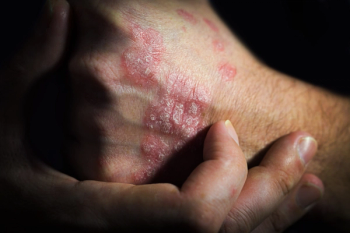
Dupilumab for Atopic Dermatitis May Increase Psoriasis Risk
Key Takeaways
- Dupilumab treatment in atopic dermatitis patients shows a 58% higher risk of developing psoriasis compared to other systemic treatments.
- The number needed to harm is 94, indicating a limited absolute risk despite the elevated relative risk.
This study reveals that dupilumab is associated with a modestly increased risk of developing psoriasis, highlighting the importance of monitoring skin reactions during therapy.
Patients with
In the context of medication adverse effects, the NNH is total patients exposed to risk factors or treated with whatever drug is being investigated before one of them experiences an adverse reaction.2 For this analysis, that means for every 94 patients treated with dupilumab, 1 additional case of psoriasis could be expected vs the other systemic therapies (corticosteroids, methotrexate, cyclosporine, azathioprine, or mycophenolate mofetil).1
The study authors highlighted that their research underscores the importance of clinical monitoring for
Data from the TriNetX Global Collaborative Network were used as the basis of the population-based retrospective cohort study. The follow-up was 3 years, and the population comprised 2 groups matched 1:1 by age, sex, race, comorbidities, laboratory measurements, and prior medications: a treatment cohort receiving dupilumab (n = 9860) and a control cohort receiving other systemic medications (n = 9860). More than half of these patients were female patients (55.2%), the mean (SD) age was 44.8 (20.3) years, and White individuals accounted for the highest percentage of patients (n = 9901; 50.2%), followed by African American or Black individuals (n = 3582; 18.2%) and Asian individuals (n = 2004; 10.2%).
Among each group, the top 3 comorbidities were the same, being asthma (21.7%, dupilumab group; 19.4%, control group), allergic rhinitis (19.6% and 17.6%, respectively), and
The difference in cumulative incidence rate at 3 years (2.86% vs 1.79%) was considered statistically significant (P < .001), in particular because of the 58% greater risk seen in the dupilumab group for developing psoriasis (HR, 1.58; 95% CI, 1.25-1.99) relative to other treatments. However, with the absolute risk difference over 3 years coming in at just 1.07 percentage points, the data suggest that the overall likelihood remains low.
However, the researchers observed that the increased risk of psoriasis persisted across many subgroups:
- Younger than 60 years (HR, 1.23; 95% CI, 0.94-1.61)
- Older than 60 years (HR, 1.77; 95% CI, 1.22-2.58)
- Male (HR, 1.55; 95% CI, 1.08-2.22)
- Female (HR, 1.63; 95% CI, 1.19-2.24),
- African American or Black (HR, 1.81; 95% CI, 0.88-3.73)
- Asian (HR, 1.85; 95% CI, 0.93-3.71)
- White (HR, 1.43; 95% CI, 1.05-1.93)
- With atopic comorbidities (HR, 1.56; 95% CI, 1.11-2.19)
- Without atopic comorbidities (HR, 1.42; 95% CI, 1.06-1.89)
- Ever had blood IgE levels above 0.048 mg/dL (HR, 1.04; 95% CI, 0.32-3.40)
- Never had blood IgE levels above 0.048 mg/dL (HR, 1.59; 95% CI, 1.03-2.01)
These data reinforce the association irrespective of certain baseline characteristics. Further, validation analyses showed that in patients with asthma who did not have AD, the risk also was still elevated, at 113% greater (HR, 2.13; 95% CI, 1.38-3.31).
Altogether, these findings suggest that the immune shifts caused by dupilumab could trigger psoriasis, particularly in individuals with an immune profile that includes inflammation primarily driven by Th17. Atopic dermatitis is considered an autoimmune disease,3 and in this class, Th17 cells are known to play key roles in both immunity and inflammation. They release interleukin-17, which is a known mediator of inflammation in autoimmune diseases.4
Despite the observed association, the authors clarify that the absolute increased risk is small and should be carefully weighed against dupilumab’s well-established benefits in controlling moderate to severe AD. They also highlight the importance of clinicians monitoring for psoriasis symptoms during treatment, especially in high-risk subgroups, while considering the overall useful role of dupilumab in AD management.
Of their findings, they note that the 58% higher 3-year risk they saw echoed a 2022 report from the World Health Organization, which showed a link between dupilumab and higher risk of psoriasis—albeit slightly lower at 48%.5
This study, they explain, draws attention to the need for ongoing research into the immunological mechanisms underlying this potential adverse effect and emphasizes balancing treatment benefits with vigilant surveillance for skin changes.
“As an open, federated system, TriNetX does not capture data from outside the network, such as over-the-counter drug use or care from nonparticipating institutions,” they conclude. “However, its integration of continuously updated data from global [health care organizations] enhances generalizability and supports large-scale clinical evaluations of newer therapies like dupilumab.”
References
- Lin TL, Fan YH, Fan KS, et al. Psoriasis risk in patients with atopic dermatitis treated with dupilumab. JAMA Dermatol. Published online June 18, 2025. doi:10.1001/jamadermatol.2025.1578
- Number needed to harm. ScienceDirect. Accessed June 17, 2025.
https://www.sciencedirect.com/topics/medicine-and-dentistry/number-needed-to-harm - Atopic dermatitis. Society for Women’s Health Research. Accessed June 17, 2025.
https://swhr.org/health_focus_area/atopic-dermatitis/ - Kimura A, Kishimoto T. Th17 cells in inflammation. Int Immunopharmacol. 2011;11(3):319-322. doi:10.1016/j.intimp.2010.10.004
- Bridgewood C, Wittmann M, Macleod T, et al. T helper 2 IL-4/IL-13 dual blockade with dupilumab is linked to some emergent T helper 17–type diseases, including seronegative arthritis and enthesitis/enthesopathy, but not to humoral autoimmune diseases. J Invest Dermatol. 2022;142(10):2660-2667. doi:10.1016/j.jid.2022.03.013
Newsletter
Stay ahead of policy, cost, and value—subscribe to AJMC for expert insights at the intersection of clinical care and health economics.












































